
Spotlight on the Bird Nest Acropora: Acropora Jacquelinae
We review a beautiful but increasingly rare species here on the Bali reefs : Acropora Jacquelinae or the Bird Nest Acropora.

Updates on our Coral Restoration Nurseries and Sites Around Bali
We revisit 3 of our nurseries Lipah Bay (Amed), Ped (Nusa Penida) and Tulamben on their progress. We are continuing to expand our restoration areas and looking for better techniques for coral restoration.
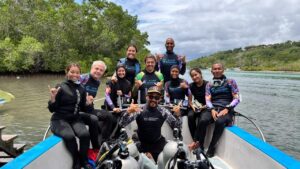
November’s Coral Restoration Full Certificate – A Month of Learning, Diving, and Restoring Hope Underwater
November 2025 became a month filled with stories for the five participants who gathered in Bali for the Coral Reef Restoration Full Certificate—a four-week learning journey that not only deepened their scientific understanding, but also strengthened their connection to the ocean and to one another as reef guardians, combining classroom theory with hands-on practice in the ocean. The three scholarship recipients—Disya Shafa Azizah, Lusiana (Blue Forest), and Daniel Jackson Jay (Trilogy Ocean Restoration, Karimun Jawa)—joined with strong motivation to expand their capabilities as restorers. They were accompanied by two self-funded participants from abroad, Mohammad Alkhonaini
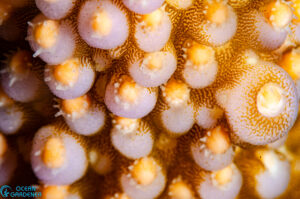
Behind the Full Moonlight: A Story of Coral Reef Life Cycles
Our staff member Anasthasia reflects on her first coral spawning in Tulamben and updates from this coral spawning season in 2025.
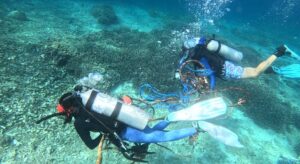
When Mooring Buoys Become a Threat to the Corals We Protect
Corals – The Hidden Foundation of Marine Life In Nusa Penida, tens of thousand of visitors visit Manta Point in Nusa Penida, Bali. But behind every manta ray, mola mola, or school of reef fish lies a hidden truth: without coral reefs, none of these creatures could survive. Coral reefs provide homes to the baby fish to hide from predators, or host the species that these iconic species feed on. Ocean Gardener has been working with the local fishermen community, Nuansa Pulau. Together, we have been planting over 200,000 corals at the Ped restoration site in

Modular, scaleable solution for sewage treatment in remote locations, the Reef Saver
While in Raja Ampat, we discovered how some communities are using a simple, modular wastewater treatment solution “Reef Saver” to minimize the impact of tourism on the local reefs.

New Acropora ID course in Banda-Neira, 16-27th December 2025
A unique experience to learn about Acropora! Ocean Gardener together with Luminocean will run their first Acropora ID course in Banda this December.

Banda Neira: Discovering a hidden paradise
Our team goes to Ambon to do a reconnaissance dive, check out the corals and ecosystem in this part of Indonesia. We share our experience in this latest blog post.
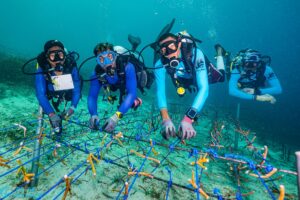
Ocean Gardener’s 4 Weeks Coral Restoration Certificate in Raja Ampat, West Papua
Jonathan takes us through our recent course done for the first time in Raja Ampat in collaboration with our partner NGOs. We live aboard Galaxea with seven scholarship recipients and learned about corals and the different methods of restoring. Follow our journey and learn about the participants in this course.
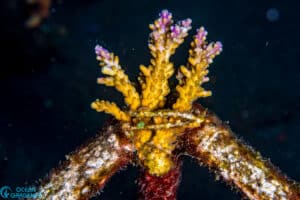
Impressive results after 2 weeks of running our Mineral Accretion Technology pilot
We revisited our first Mineral Accretion Technology (MAT) after 2 weeks to monitor its progress. You can read our previous blog post about the MAT system installation. It goes through the installation process and technical details of our pilot site in front of our partners, the MERO Foundation, in Tulamben, East Bali. It took many years to convince us to try Mineral Accretion Technology (MAT). Like many, we had been disappointed with the published results achieved by various organizations using this technique in their own projects. Nevertheless, being stubborn, we preferred to see for ourselves
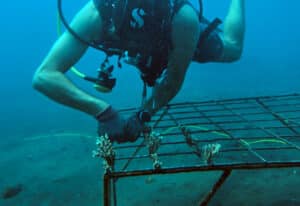
Our Mineral Accretion Technology Pilot Test
Last month, Ocean Gardener started a pilot trial for Mineral Accretion Technology (MAT) in Tulamben, East Bali, to assess its effectiveness in promoting faster and healthier coral growth compared to existing methods. We go behind the scenes for a look at how we did it and the materials we chose.

Sustaining What We’ve Planted: The Importance of Coral Reef Maintenance with Local Communities in Bali and Nusa Penida.
We know successful coral reef restoration is more than just planting fragments; it requires long-term maintenance and community involvement. In this article, we explore what that means and how we collaborate with the local community.